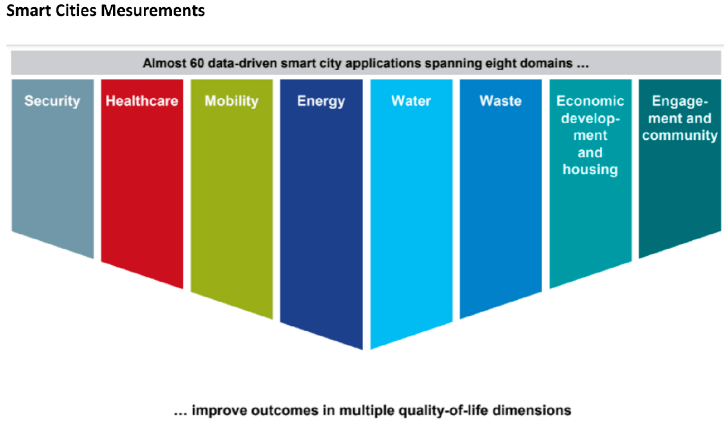This article is the second of a series dedicated to smart technologies and cities. Through these readings, I propose a comprehensive approach to decipher the future urban challenges that smart cities and mobility will have to face for a better, safer and more sustainable future for all of us.
With the increasing global population and the massive people flow from a rural environment to cities, one of the main purposes of a future smart city will be to be able to support its urban expansion. Due to its holistic characteristic, mobility should be the top priority of city regulators to find concrete solutions to these future challenges. I like the analogy of people being the heart and mobility the blood working in symbiosis for the entire body (i.e. the city).
The McKinsey Global Institute developed a framework in 2018 with 8 domains where smart technologies can support smart city urban expansion.

To address each one of these domains, cities will have to invest in a multitude of sectors that, according to the Business and Sustainable Development Commission, may represent an aggregate global smart city market of over £1.1 trillion by 2030, with a break down as followed:

Smart City Global Market — Based on Business and Sustainable Development Commission
Autonomous MaaS market could worth up to US$426 bn by 2030
I am personally convinced that the “Smart Transport” bucket would account for much more than these forecasts. I am currently conducting a research about the future autonomous mobility value chain. I found out – based on different forecasts from respected institutions – that only for the autonomous vehicle-related Mobility-as-a-Service (MaaS) part of the global autonomous vehicle industry, this specific section could have a market value up to US$426 bn by 2030.

This prediction does not include regular MaaS, public transport, micromobility, and other mobility solutions…
Therefore, getting enough money to translate the vision into action is critical. To finance this massive smart city global market, Pallares and Hernandez identified different sources with their related importance that smart cities may leverage:

Financing the Smart City Global Market — Based on Business and Sustainable Development Commission
The world largest 100 cities are responsible together for almost 20% of the global carbon emissions
Smart cities will also have to tackle climate change, which is a transversal issue across the 8 McKinsey domains. The world largest 100 cities are responsible together for almost 20% of the global carbon emissions. Experts say that the majority of this carbon footprint is due to the emissions related to transports. According to a European study, “urban mobility accounts for 40% of all CO2 emissions of road transport and up to 70 % of other pollutants from transport.”

The graph below shows the global CO2 emissions per sector for a complete overview.

Traffic congestion costs EUR 100 bn per year in EU
Unfortunately, the mobility status quo is not only costly for the environment but also for the economy. Congestion due to traffic jams costs in the EU nearly EUR 100 bn per year and this trend does not show any sign of improvement; of the top 20 cities in the semi-annual INRIX Global Traffic Scorecard, almost half experienced worsening congestion.
In Rome, each driver wastes 254 hours per year in traffic jams
Some, like Rome, saw the hours lost to congestion rise up to 254 hour per driver per year! Imagine what you could achieve with this amount of time…
Still not convinced why mobility is certainly the most important aspect of a smart city? Have a look at what follows…
With a high car ownership rate (579 vehicles/1000 habitants), dense cities and the need to take the plane for almost all travels outside of the country, it is not surprising that the UK is the 3rd largest country in the world in terms of CO2 emission per person. The footprint is mainly driven by the mobility pollution generated per individual.

If China and India had the same car ownership per person ratio than in the US, we would have an addition of billions of cars on the planet
China has the second place of the podium with a car ownership ratio as low as 173 vehicles per 1000 inhabitants. If we work out the calculation to align this rate with the US vehicle ownership rate (811 cars/1000 pers), there would be more than 1.1 billion cars on Chinese streets (against ~300 million today). Needless to say, working out the same calculation for India would give an astronomic number as well.

Mobility impacts directly a wide range of other industries and can solve concrete problems such as pollution
Now we understand why mobility is a key enabler to smart city, let’s change our transportation habits and embrace the diversity of mobility solutions surrounding us [discussed in the next article] to make an impact that matters for our environment.
About Me
Frederic is a Consultant at Neckermann Strategic Advisors. He holds an MBA from Imperial College London Business School and a Master’s Degree in Business Engineering from UMons. He supports companies in understanding how the Mobility Revolution will change their business. Frederic is the co-author of multiple smart mobility research reports and one of the contributors to the Global New Mobility Coalition led by the World Economic Forum. He is also a mobility guest lecturer at Universities, a blogger @ Frederic-john.com and mentors mobility start-ups in London and Singapore. He is fluent in French and English and also speaks some Spanish and Dutch.
The views expressed in this article are personal and do not represent the opinion of my employer or any other parties I am involved with. The suggested insights come from my discussions, research and analyses.

